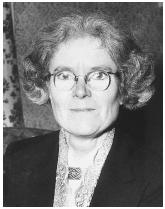Kathleen Lonsdale

IRISH CRYSTALLOGRAPHER
1903–1971
Kathleen Lonsdale was born Kathleen Yardley in Newbridge, Ireland, on January 28, 1903. She was the youngest of ten children (four of whom died in infancy). In 1908 Lonsdale's mother, Jessie, separated from her husband and emigrated with her children to England. Lonsdale was a bright child, and although the older children had to leave school and go to work, she stayed in school and was allowed to enroll in Bedford College, University of London, at age sixteen, to study mathematics and, later, physics. She graduated in 1922 at the top of her class and her teacher and mentor, the eminent English physicist Sir William Henry Bragg, recruited her to join his research group in London. She began to work in x-ray crystallography (the analysis of crystal structure by means of x rays), then a new field, and became a leading scientist in this field.
In 1927 Lonsdale married Thomas Lonsdale and she and her husband lived in Leeds, England, for three years. There she was given crystals of hexamethylbenzene and hexachlorobenzene for analysis by the English chemist Sir C. K. Ingold. She subsequently confirmed that the benzene ring was flat, with all carbon-carbon angles and bond lengths identical. Hers was the first experimental proof. Ingold said of her published account of benzene structure, "[O]ne paper like this brings more certainty into organic chemistry than generations of activity by us professionals." She was the first scientist to apply Fourier analysis (a type of mathematical analysis) to the analysis of crystal structure.
In 1930 Lonsdale moved back to London. In London she brought up three children while conducting research at home. In 1931 she rejoined Bragg at the Royal Institution of Great Britain and there (using the rooms of the great Michael Faraday) continued her work in the analysis of crystals. She stayed at the Royal Institution until 1946. Her major contribution to chemistry and physics was to establish the theoretical foundation of crystallography. Lonsdale helped to create the structure factor tables that are used by present-day crystallographers, and edited the International Tables of X-Ray Crystallography (1935), the "crystallographer's bible."
In 1946 Lonsdale moved to University College, London (UCL), where she became professor of chemistry in 1949 and remained until her retirement in 1968. With great modesty she said she knew very little chemistry, and no organic chemistry. She gathered about herself a large research group and trained many crystallographers. She worked on many crystal structure problems, including the clarification of the structure of diamond and the nature of urinary stones.
Lonsdale accrued many "firsts": one of the first two women to be elected Fellow of the Royal Society (1945); the first woman professor at UCL (1949); the first woman to become president of the International Union of Crystallography (1966) and of the British Association for Science (1968). It is partly because of her example and influence that women have been so prominent in crystallography.
Lonsdale became a Quaker in 1936 and went to jail in England for her participation in conscientious objection during World War II. After the jail experience she became active in prison reform and later in the international peace movement. Her political activism was as significant to her as her scientific achievements. Among her books were Is Peace Possible? (1957) and The Christian Life Lived Experimentally (1976) and she saw no conflict between her faith and her science, nor between being a wife and mother and being a scientist.
Lonsdale continued to work in various ways (including scientific, educational, and charitable work) during her official retirement. She died on April 1, 1971. In 1981 the chemistry building at UCL was named the Kathleen Lonsdale Building in her honor.
SEE ALSO Bragg, William Henry ; Organic Chemistry ; Solid State .
Peter E. Childs
Bibliography
Childs, Peter E. (2003). "Woman of Substance." Chemistry in Britain (January):41–43.
Julian, M. M. (1990). "Women in Crystallography." In Women of Science, ed. G. Kass-Simon and Patricia Farnes. Bloomington: Indiana University Press.
Laidler, Keith J. (1997). "Kathleen Lonsdale (1903–1971)." Chem13 News 255:1–5.
Lonsdale, Kathleen (1968). "Human Stones." Scientific American 219:104–111.
Internet Resources
Childs, Peter E. "Kathleen Lonsdale 1903–1971." Available from http://www.ul.ie/~childsp/ .
Contributions of 20th Century Women to Physics. Kathleen Yardley Lonsdale. Available from http://www.physics.ucla.edu/~cwp .
Comment about this article, ask questions, or add new information about this topic: